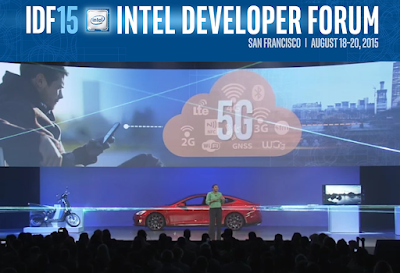 Intel intends to leverage its unique combination of computing, networking and wireless communications assets "to develop 5G solutions that integrate intelligence across the entire network, end-to-end, from the data center to device and throughout systems in between."
Intel intends to leverage its unique combination of computing, networking and wireless communications assets "to develop 5G solutions that integrate intelligence across the entire network, end-to-end, from the data center to device and throughout systems in between." Intel has launched a Network Builders Fast Track to guide its efforts with the networking industry in accelerating innovation in the 5G ecosystem. Under the program, Intel is collaborating with equipment and device manufacturers, network operators, service providers, academic institutions. Intel Capital will alos make strategic investments in disruptive companies that are part of the Intel Network Builders program.
 At this week's IDF15 in San Francisco, Intel executives Aicha Evans and Sandra Rivera hosted a panel discussion with Dr. Alex Choi, CTO of SK Telecom, Bin Shen, Verizon’s VP of Strategy and Paul McNamara, VP in Ericsson’s Corporate Strategy Group to discuss how computing and communications will converge in 5G network.
At this week's IDF15 in San Francisco, Intel executives Aicha Evans and Sandra Rivera hosted a panel discussion with Dr. Alex Choi, CTO of SK Telecom, Bin Shen, Verizon’s VP of Strategy and Paul McNamara, VP in Ericsson’s Corporate Strategy Group to discuss how computing and communications will converge in 5G network.The underlying theme is that 5G connections to cloud-based computing, data services and other connected devices, will enable self-driving automobiles with intelligent traffic routing, smart cities, connected health innovations, etc..
Some outtakes from Intel:
- Computing and Communications Will Converge: 5G will not be about simply increasing speed and capacity, but will also be about intelligence throughout the network to enable devices and the network to communicate more efficiently, transport data and content more quickly, and share computing resources. Devices and the network will also need to work together to establish intelligent service awareness. They will need to prioritize actions based on level of importance and be flexible enough to accommodate many devices that have widely varying connectivity, processing, power and latency requirements.
- Devices and Sensors Get Smaller and Smarter: Devices will evolve in size, form, function and computing capability on the road to 5G. Networks and devices will need to intelligently manage connections as users move in to, out of and between cell coverage areas, as well as suppress interference from neighboring cells. They will also take a greater role in sharing contextual information, creating opportunities for developing new breeds of video, web browsing, gaming and interactive cloud-based applications.
- Building a Network for the Future: Increasingly, networks must be designed to be flexible, efficient and scalable in order to accommodate the rapid growth in number and variety of connected devices in the Internet of Things, including wearables and immersive services like augmented reality. This will require new wireless spectrum and greater network efficiency.
http://download.intel.com/newsroom/kits/idf/2015_fall/pdfs/Intel-5G_MegaSession_Factsheet.pdf
A replay of the session video
http://intelstudios.edgesuite.net/idf/2015/sf/megasession/150819_aesr/index.html














